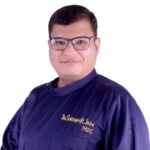Home › Forums › Occlusion & TMJ › TMJ Pain Management With Cervical Management
Welcome Dear Guest
To create a new topic please register on the forums. For help contact : discussdentistry@hotmail.com
- This topic has 2 replies, 2 voices, and was last updated 09/06/2024 at 6:13 pm by
 doctorsorabhjain@gmail.com.
doctorsorabhjain@gmail.com.
- This topic has Query prefix assigned
-
AuthorPosts
-
08/05/2024 at 7:00 am #26060
 doctorsorabhjain@gmail.com
OfflineRegistered On: 21/05/2016Topics: 10Replies: 7Has thanked: 0 timesBeen thanked: 2 times
doctorsorabhjain@gmail.com
OfflineRegistered On: 21/05/2016Topics: 10Replies: 7Has thanked: 0 timesBeen thanked: 2 timesHello All…
Esteemed Colleagues,
I present to you a case of Temporomandibular Joint (TMJ) dysfunction, warranting detailed evaluation and management considerations.
Chief Complaint:
The patient presented with acute pain and chronic discomfort localized to the right TMJ region, characterized by pain exacerbated during mastication and restricted mandibular movement.
- History of Presenting Illness:
The onset of symptoms in December 2023 marked a notable departure from the patient’s previously asymptomatic state. Subsequent to this, in January 2024, an acute episode ensued, manifesting as limited mouth opening upon arousal from sleep. Despite initial attempts at self-medication and conservative measures, including analgesics and heat application, the symptoms persisted, prompting professional intervention. Initial assessment by a dentist suggested a putative association between the TMJ pain and the presence of the lower right wisdom tooth. Consequently, surgical extraction of the wisdom tooth was performed, albeit without significant amelioration of symptoms. Upon incomplete satisfaction, Seeking further resolution, the patient pursued additional consultations, which yielded recommendations for a tailored regimen of pharmacotherapy and few exercises. However, despite adherence to this regimen, the patient reported only transient relief, with persistent exacerbations of discomfort and functional impairment. This protracted clinical course culminated in the patient seeking tertiary care intervention, thereby precipitating her presentation to our clinic after a lapse of four months. Concurrently, the patient reported concomitant dental hypersensitivity affecting both upper and lower posterior dentition, alongwith pain chewing from right side.
Examination Findings:
Clinical examination revealed a spectrum of relevant findings:
Evaluation of the dental arches identified a buccal cusp facial fracture localized to tooth 26, with no involvement of the cusp tip.
Provocative testing, including air blast stimulation, elicited pronounced sensitivity localized to tooth 47, with accentuated responses observed in teeth 17 and 16 as well.
Radiographic imaging via intraoral periapical radiography (IOPA) demonstrated conspicuous widening of periodontal ligament (PDL) spaces around teeth 46 and 47, indicative of underlying pathological processes, suggestive of Overloading, leading to a condition known as Frictional Dentinal Hypersensitivity.
Palpation of the right temporomandibular joint elicited localized moderate to severe tenderness and restricted range of motion.
Noteworthy tenderness was also elicited upon palpation of the right masseter (Upper fibres region – moderate pain and middle fibres region – mild pain) and of the right trapezius muscle (upper region towards shoulder – severe pain), suggestive of myofascial involvement.
The patient reported prior engagement in a structured physiotherapy program, which provided temporary symptomatic relief, albeit with recurrent exacerbations during periods of increased functional demand.
Occlusal assessment revealed aberrant interferences during centric relation positioning, accompanied by a pathologic slide upon closure, particularly evident in the molar regions, unilaterally, notably teeth 17 and 47.
Imaging Findings:
Orthopantomographic (OPG) imaging demonstrated a notable absence of radiographic abnormalities, with no overt evidence of bony pathology or structural aberrations within the maxillofacial complex.
Management Plan:
In light of the nuanced clinical presentation and multifactorial etiology, a comprehensive management strategy is warranted:
Implementation of a structured physiotherapy program tailored to address myofascial dysfunction and restore optimal musculoskeletal function, with emphasis on manual therapy techniques, therapeutic exercise regimens, and ergonomic modifications.
Consideration of pharmacological adjuncts, if needed occasionally or rarely, depending upon symptoms, includes nonsteroidal anti-inflammatory drugs (NSAIDs) & muscle relaxants for adjunctive pain management and symptom control, if required.
Collaborative liaison with advanced Dental Technology, Tscan, will be put to use. to address residual dental hypersensitivity through targeted desensitization modalities as this is due to Interference observed at 16,17, 46 and 47 region and adjunctive restorative procedures, as indicated.
Conclusion:
This case underscores the inherent complexity of temporomandibular joint disorders and underscores the imperative for a systematic, multidisciplinary approach to diagnosis and management. Further updates on the case will be provided as warranted by clinical progression.
For reference, please find attached the video presentation on the TMJ case.
Your constructive insights and recommendations are earnestly welcomed as we endeavor to optimize patient care and outcomes.
Dr. Sorabh Jain | Cranio-facio-Mandibular Prosthodontist | Special Interest in TMJ management| Special Interest in Dental Sleep Medicine | Neuromuscular Principles Based Dentistry | DIgital Occlusion | Complete Dentures
+91-7303302651
www.DrProstho.com21/05/2024 at 9:21 am #26074 Sanjay Arora
OfflineRegistered On: 16/04/2021Topics: 1Replies: 1Has thanked: 0 timesBeen thanked: 1 time
Sanjay Arora
OfflineRegistered On: 16/04/2021Topics: 1Replies: 1Has thanked: 0 timesBeen thanked: 1 timeThis is easily curable in 5-15 minutes in 80-90 percent patients with ALPDC Technique.( All complaints)
-
This reply was modified 1 year ago by
 Sanjay Arora.
Sanjay Arora.
09/06/2024 at 6:13 pm #26096 doctorsorabhjain@gmail.com
OfflineRegistered On: 21/05/2016Topics: 10Replies: 7Has thanked: 0 timesBeen thanked: 2 times
doctorsorabhjain@gmail.com
OfflineRegistered On: 21/05/2016Topics: 10Replies: 7Has thanked: 0 timesBeen thanked: 2 timesThis is easily curable in 5-15 minutes in 80-90 percent patients with ALPDC Technique.( All complaints)
-
This reply was modified 1 year ago by
 Sanjay Arora.
Sanjay Arora.
Sir, can you please elaborate more about the technique?
Dr. Sorabh Jain | Cranio-facio-Mandibular Prosthodontist | Special Interest in TMJ management| Special Interest in Dental Sleep Medicine | Neuromuscular Principles Based Dentistry | DIgital Occlusion | Complete Dentures
+91-7303302651
www.DrProstho.com -
AuthorPosts
- You must be logged in to reply to this topic.